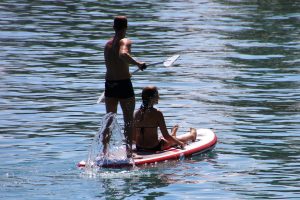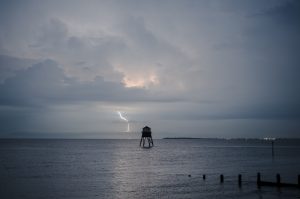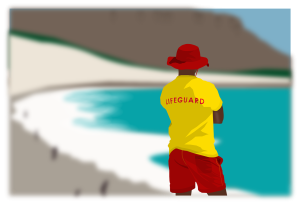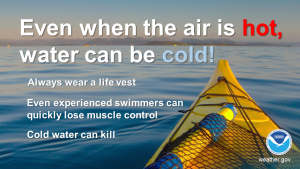What is open water?
Open water may be large bodies of water to include lakes, reservoirs, rivers, bays, oceans, and some large ponds.
| Open Water | Swimming Pool |
 |
 |
Open water conditions may vary from hour to hour with limited or no visibility. Swimming pools typically are chemically treated, clear and environmentally controlled. Differences and challenges may include:
- Tide changes
- Currents
- Drop offs
- Submerged hazards
- Encroaching watercraft
- Hazardous marine life such as jellyfish
- Surf conditions
- Little or no visibility
- Changing weather conditions
- Wind
- Potentially dangerous structures such as piers, jetties and rock formations that may also present surveillance blind spots
- Surveillance blind spots may also include waves, glare, trees and islands.
Open water activities - what are they?
Open water activities include swimming, wading, snorkeling, surfing, water skiing, jet skiing or use of other motorized personal watercraft, tubing, rafting, kayaking, paddle boarding, boating, fishing, SCUBA, or participating in open water events.
What is an open water event?
Open water events are increasing in popularity. These events may include, triathlons, aquathlons (swim/run), river swims, cold water splash activities, beach or pier swims, long distance swims, multi-sport events to include paddling with swimming, paddle races, open water sprints, or other competitive or fundraising events occurring in open water.
What are the dangers of open water activities?
Open water can include a variety of environments, and therefore a variety of hazards.
Dangers associated with open water activities can include:
- Open water could be deep or cloudy making it hard to see. Currents or waves could distort or limit visibility, while churning water or waves create surf and bubbles, also restricting vision. There could be a glare or reflection on the water impairing one’s ability to see what is happening under the water’s surface.
- Limited visibility can make it hard to see if someone is drowning or if someone is submerged under water. It can also make it hard to see underwater hazards like rocks, downed trees or snags, thick vegetation or wildlife.
- The depth of open water could be very deep, or change drastically within a short distance, or the water conditions may make it difficult to know how deep it is.
- Natural waters may have unknown drop offs, sandbars, rocks, and currents that may move swimmers to a different depth than where they were planning to be.
- Rivers and oceans, and even some lakes, will have currents that can move swimmers away from shore, or away from their boat or other floatation device.
- Tides can create a change in water depth and conditions, or increase in force or size depending on the weather and other conditions.
- Most people don’t want to swim in cold water, but sometimes events like the Polar Plunge, or other cold water events, might put swimmers at risk for hypothermia.
- Hypothermia can set in when the body is exposed to low temperatures for a period of time. How quickly a person develops hypothermia depends on the person, the temperature and the length of time they are in cool or cold temperatures.
- Hypothermia can occur in any water temperature below 70°F.
- Hypothermia is very dangerous and can cause death. Hypothermia affects the brain and the body. It can cause a person to not think clearly or move well.
- Visit the CDC webpage on Cold Stress-Cold Water Immersion for more information.
- Know the water temperature and plan your swim time and equipment appropriately.
- If you are swimming in cold water a wetsuit may be a good option.
- If you are swimming in warm water, a wetsuit might actually lead to heat exhaustion.
- Have a plan.
- If you are participating in a long distance open water event water temperatures may vary throughout the course. Have a support team, extra equipment, and an emergency plan.
- Make sure people know where you are and what you are planning to do. Don’t go out alone - Have a buddy!
- Check the forecast before you leave and during your time outside. Weather conditions can change quickly and unexpectedly. If you see a sudden weather change, return to shore. It’s generally not safe to swim in the rain.
- Watch the sky. Not all forecasts are correct. If you see weather approaching, take action and get out of the water. Get to a safe location.
- Listen for thunder. You may hear thunder before you see lightning.
- If you hear thunder or see lightning, get out of the water immediately.
- Stay inside for at least 30 minutes after hearing the last thunderclap.
- Lightning can kill! Learn more by visiting the National Weather Service webpage on Lightning Safety Tips and Resources.
Visit CDCs Lightning Information for Water Activities to learn more about lightning and water activities.

- Natural waters are the home to many species of fish and other aquatic animals. Know what you are swimming with and how it may impact your safety.
- Some animals can present danger to swimmers. Jellyfish, sharks, snakes, and other aquatic animals might interact with swimmers causing stings, bites or other injury. Stay away from wildlife.
- Harmful algal blooms (HABs) can be hazardous. Algae are naturally-occurring microscopic organisms that are found in fresh and salt waters of Virginia and around the world. Most algae do not harm people, wildlife, or the environment. But some types of algae in Virginia can be dangerous. Visit VDH’s Harmful Algal Blooms webpage for more information.
How to stay safe with open water activities.
- Learn how to swim!
- Swim in designated areas and under the supervision of a qualified lifeguard. Check with the lifeguard concerning current water conditions.
- Always swim with a buddy. Never swim alone and communicate to others when and where you plan to swim.
- Avoid swimming or boating after dark.
- “When in doubt - get out” - if the water conditions change, or you’re getting tired, or something isn’t right, get out of the water.
- Know your environment. Be aware of water and weather conditions.
- Know your equipment. If you are swimming or boating long distances, make sure you have floatation and backup equipment.
- Wear a life jacket.
- Learn Lifesaving Skills.
- Have an emergency plan.
Lifeguards
 Lifeguards are trained to prevent injuries and save lives, and respond to water incidents.
Lifeguards are trained to prevent injuries and save lives, and respond to water incidents.
Increase your margin of safety while swimming - listen to the lifeguard!
If you are a lifeguard, consider getting trained in open water guarding by participating in an Open Water Safety Training program. This training can build on your existing skills and expand your knowledge and abilities by learning how to use equipment involved in open water swimming events and rescue. Protect and save lives at another level!
Lifeguards should possess a current nationally accepted lifeguard certification such as the American Red Cross, YMCA or equivalent.
Certified lifeguards are typically trained to recognize and respond to water and land emergencies such as distressed swimmers, active drowning victims, passive drowning victims, spinal injuries, cardiac arrest incidents, sudden illness and other medical events. These are all good skills to build on when training to be an open water lifeguard and/or working open water swimming events.
Training Considerations Include:
- Higher physical competencies to include increased swimming distances and running.
- Use of equipment such as two=way radios, megaphones, binoculars, surf rescue boards, kayaks and rescue buoys.
- Site specific rescue drills in surf and deep water.
- Coordination with support agencies to include fire and law enforcement.
Resources
- Visit VDHs Drowning Prevention webpage for more information on drowning prevention.
- The American Academy of Pediatrics (AAP) recommends that every family learn to swim. Swimming lessons have been shown to be beneficial for children as young as age one, but parents should consult with their pediatrician to determine when their child is ready.
- Visit the VDH Lifesaving Skills webpage for more information.
- The VDH Pool & Water Safety webpage provides safety information for open water activities and provides the following guidance:
- Learn Cardiopulmonary Resuscitation (CPR). You can save a life while waiting for paramedics to arrive.
- When boating in open waters, be sure to wear U.S. Coast Guard- approved life jackets, regardless of the distance to be traveled, the size of the boat, or the swimming ability of the boaters.
- Teach children to swim. Participation in formal swimming lessons can reduce the risk of drowning among children between 1 and 4 years old.
- With any recreational water activity, always use the buddy system, be aware of local weather conditions, do not consume alcohol before or during recreational water activities, avoid swimming after dark, do not dive into unknown or shallow areas and watch out for dangerous waves or rip currents.
- Never rely on flotation devices or swimming lessons to protect a child. Twenty-five percent of all drowning victims have had swimming lessons.
- Risk for drowning increases in muddy water of lakes, ponds, and rivers.
- Avoid weak or thawing ice on any body of water.
- The United States Lifesaving Association is America's nonprofit professional association of beach lifeguards and open water rescuers . The USLA works to reduce the incidence of death and injury in the aquatic environment through public education, national lifeguard standards, training programs, promotion of high levels of lifeguard readiness, and other means.
- The CDC Healthy Schools Water Safety program reminds kids to watch out for sunburn and wear sunscreen. It’s also important to know boater and swimmer safety. Visit the CDC website for more information.
- Visit the CDC website to learn more about steps to take when you visit oceans, lakes, rivers, and other natural bodies of water.
- Visit the National Drowning Prevention Alliance (NDPA) website for more information on Open Water Safety.
- National Oceanic and Atmospheric Administration (NOAA) & the National Weather Service provide information related to
- The American Red Cross reminds people to:
- Always swim in a lifeguarded area.
- Never swim alone, regardless of your age or level of swimming skills.
- Keep within your fitness and swimming capabilities.
- Be aware of weather and water conditions and heed warnings.
- Consider swim classes for the entire family.
- Understand how to swim safely at the beach, or in the ocean
- Know where the lifeguard is and follow instructions
- Be aware of sandbars, rip tides, and marine life (jellyfish)
- Understand rip currents and how to avoid or get out of them
- Understand how to swim in lakes, rivers and other open waters
- Be aware of air and water temps
- Weather (Thunder, lightening)
- Currents
- Hazards such as dams, underwater obstacles, rocks, submerged debris
- Vegetation, animals, and fish
- Other people (boats, fishing)
- Know your level of swimming

